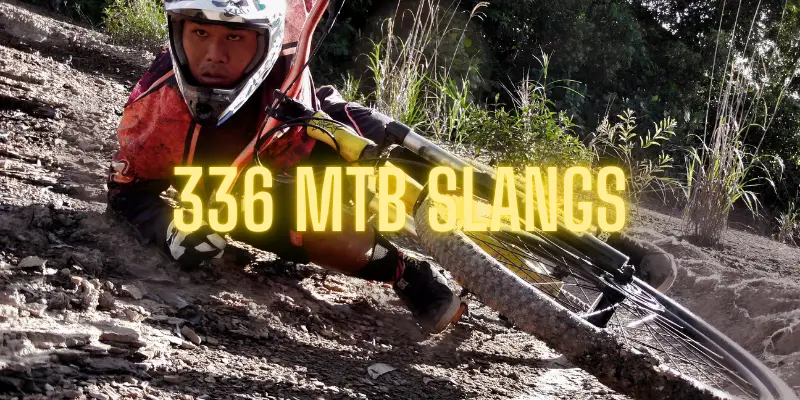Sure, mountain biking is exciting, but what’s the fun in it, if you don’t have the right lingo to describe your passion? The first time I heard the word “danger noodle”, it was on the trail. We were being warned to be careful of danger noodles and in my naivety, I thought it referred to some kind of poisonous noodle.
Haha. Imagine my shock and embarrassment when I was told by fellow riders that danger noodle is a mountain biking lingo for snakes.
In this article, I’ll pimp up your vocabulary so you don’t get lost in any conversations on the trail. I have compiled a glossary of words to help you get accustomed to MTB slangs and terminologies.
So, let’s get cracking!
MTB Slang Meanings
A
A-FRAME: A boardwalk constructed to help riders get over obstacles such as fallen trees. From the side, the boardwalk’s shape looks like the letter “A”.
A-LINE: A challenging section of trail that may have features like jumps, drops, and rock gardens for experienced bikers. A-line is also the name of a very famous jump trail in Whistler Mountain Bike Park.
ALL-MOUNTAIN: This MTB lingo refers to all-purpose trail bikes, which are mountain bikes designed to handle pretty much any trail conditions you can throw at them during a full day of riding. It also refers to a type of mountain bike riding that involves steep climbing, large drops, and more technical sections than the cross-country discipline. May also be called Enduro.
ALL MOUNTAIN BIKE: This kind of bike is what you need to ride the enduro mountain biking style. It’s tougher and longer-lasting than an XC (cross country) bike. It also devours steep hills and performs really well on descents.
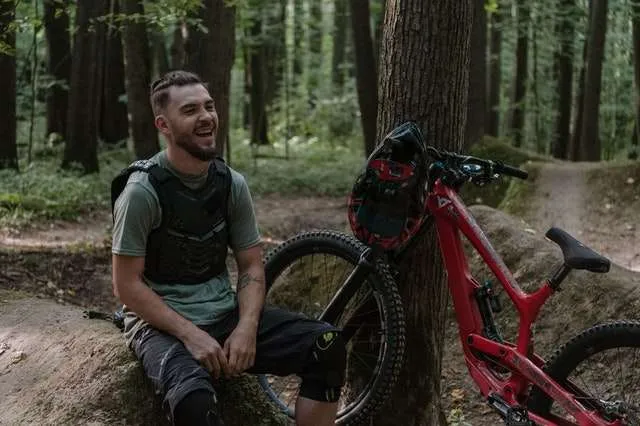
ALLEN KEY/ALLEN WRENCH: A tool used to adjust Allen head bolts that comes in multiple sizes and configurations.
ALLOY: An alloy bike is a bicycle with an aluminum alloy frame. Alloy frames are heavier than carbon frames but lighter than steel. Although the frame is light and stiff, it’s not the most durable.
AM: Abbreviation for All-mountain.
APEX (clipping-point): The apex is the geometric center of a turn that allows the rider to take the straightest line through the turn while maintaining high speed.
ARMOR: A trail covered by hard materials such as bricks, concrete, etc. against erosion. Also protection for riders such as knee/elbow pads, gloves, helmet, etc.
ATTACK POSITION: a fundamental skill in mountain biking, The attack position is the body position a rider should have when entering into unknown and technical sections of trail. It is characterized by bent knees, rear above the saddle, elbows slightly bent, and a raised head.
B
B-LINE: An easier option compared to an A-line. The preferred option for amateurs.
BABY HEADS: large round rocks on the trail.
BAGGIES: Loose shorts worn when riding. They’re more comfortable than Lycra, abrasion resistant, have extra pockets and remain warm even in cold temperatures.
BAIL: To jump off your bike to avoid a serious crash.
BANDIT TRAIL: A trail built on someone else’s property, usually without permission and illegally.
BARK TATTOO: A mountain biking term for an abrasion when you graze a tree at high speed during a ride.
BARREL ADJUSTER: A knob that adjusts shift cable tension.
BERM: A corner on a trail that has been intentionally banked to provide more grip and increase trail flow. This trail feature is created by heaping soil around a flat corner to convert the bend into a more rideable trail section.
BIBS: Padded cycling shorts that feature shoulder straps. Can be worn alone or under baggy shorts.
BIFF: Crash. Also called a wipeout.
BIKEOHOLIC: A mountain biking addict/a cycling addict.
BOARDWALK: A man-made surface usually made of wood that extends a trail over or across a gap that’d be extremely challenging to get over, especially for a beginner.
BOMB: To go as fast as you can down a trail with little regard for the consequences.
BONK: Running out of energy so suddenly that you simply can’t go on. Symptoms of bonking include poor balance, worse line choice than usual, etc.
BOOTER: A small little jump either in the middle of the trail or off to the side. Booters tend to form from natural objects that are already on the trail like roots, tree stumps, and rocks.
BOTTLE CAGE: A cage made from plastic, metal or carbon that connects to your bike frame and holds your water bottle.
BOTTOM BRACKET: A set of bearings inside of a shell that sits inside your frame which allows the cranks to spin. On a bike, the bottom bracket is where the crankset connects to the frame and the pedals rotate.
BOTTOM OUT: When there is so much force that your bike’s suspension travel is all used up and an audible thud can be heard and felt.
BRAKE BLEED: Flushing hydraulic brake lines with clean hydraulic fluid to remove air bubbles and contamination.
BRAKE CALIPER: Houses a disc brake’s pads, piston and brake fluid. Think of them like a clamp. They’re crucial for creating friction that slows down your brake rotors or discs.
BRAKE PADS: Brake pads are what squeeze a brake’s disc to slow down the bike. They sit in the brake calipers and are activated by brake pistons.
BRAKE PISTON: Pistons are pushed by hydraulic fluid to slow down your bike when you engage the brake. Picture this: when you pull the brake lever, there’s a small piston or plunger inside of the lever that forces fluid through the hose and into the caliper. When fluid is pushed into the caliper, the pistons push outward, squeezing the brake rotor to slow down your bike.
BRAKE: What you use to slow down when riding.
BRAKING POINT: This is the optimal point or general zone before a corner. Here, a rider has to slow down before entering the corner or technical feature.
BRAP: A mountain biking term for the sound of knobby mountain bike tires on the trail.
BREAKAWAY: A style of helmet that has a removable chin guard. It can be used as a typical ‘half lid’ helmet or as a ‘full-face’ DH helmet depending on the terrain. Simply snap on or remove the chin guard based on what you plan to ride.
BRIDGE: This is usually constructed over obstacles such as streams or ditches. Also called a boardwalk.
BROWN POW: Also known as hero dirt. Brown pow refers to optimal riding conditions like grippy loam and slightly damp soil.
BSO: Abbreviation for Bike Shaped Object. Refers to a low-quality bike that sucks at off-road cycling.
BUNNY HOP: A riding technique that helps you get over obstacles. You get both wheels off the ground, but not at the same time.
BURP: The burping sound produced when a tubeless tire suddenly loses much of its pressure.
Check out our guide to mountain biking in the rain
C
CABLE HOUSING: A protective hose that a cable sits in.
CADENCE: Pedaling rhythm. How fast you rotate your pedals per minute.
CAMBER: This is the angle of a trail. When the angle of a trail is off-camber, it’s advisable to build a boardwalk to level it out.
CARBON FIBER: A composite material used to make performance bike frames and parts.
CARBON: Carbon frames are the finest, strongest, and lightest bike frames.
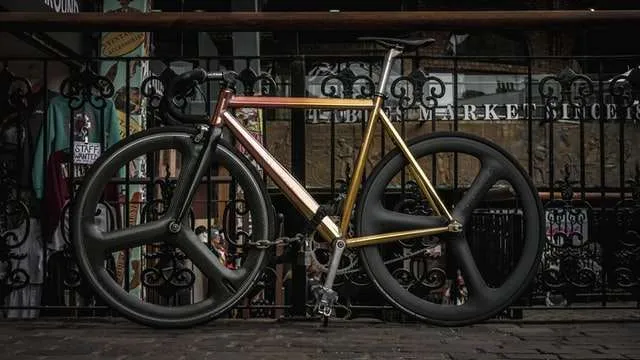
CASE PAD: This is the top portion of a jump’s landing that is built to accommodate casing. Even with a case pad, casing can sometimes cause crashes.
CASE: This is when a rider doesn’t clear a jump completely and their back tire clips the top of the landing. Sometimes, casing can cause no harm but at other times, it can pitch the rider over the handlebars.
CHAIN GUIDE: This is installed to prevent the chain from slipping off a chainring. However, it’s not as common since 1x chainring technology has improved.
CHAIN LINK: A chain is made up of individual links. A master link is the final link that connects the chain.
CHAIN RING: It is the toothed wheel near the front wheel of a mountain bike. This part links the chain to the crankset. It also pulls the chain round, causing forward motion. Synonyms: Chain Wheel and Sprocket
CHAIN SLAP: This is the noise and feel of the bike chain hitting the chainstay.
CHAIN STAY: This is the section of your bike that connects the bottom bracket to the rear axle. The chain often slaps against this part of the frame when riding through rough sections of trail. You can purchase protective covers for your chainstay to prevent this.
CHAIN STRETCH: This is simply chain wear. If the chain of your bike starts to rattle and grind during rides, the likely cause is chain-stretch.
Related article: Learn how to tighten your chain
CHAIN SUCK: When you upshift or downshift and your chain fails to disengage correctly from the chainring you’re shifting from, it means you have a chainsuck.
CHAIN TATTOO: When you brush your leg against your MTB’s chain, the greasy stain you get is called a chain tattoo.
CHAIN: This powers the bike when the pedals are turned.
CHAMOIS: Pronounced ‘shammy’. When someone says my chamois, they’re most likely talking about their bike shorts. But chamois strictly means the padded foam around the crotch area of biking shorts that helps minimize chafing and skin tear.
CHATTER: A trail section with tons of loose rocks. It is also the sound your bike’s knobby tires make when rolling over chatter.
CHUNDER: Chunder is another way of describing extremely rocky, technical terrain—particularly a rock-strewn downhill.
CHUNKY: When a trail has a lot of embedded rock (as opposed to chundery, which refers to more loose rocks).
CHUTE: A steep and narrow descending trail feature.
CLEAN: To ride through a tough section of trail without crashing, stopping, or taking your feet off the pedals.
CLEAT: Connected to a shoe and clips into clipless pedals.
CLIMB: Any uphill section of trail.
CLIPLESS: May sound confusing, but this term actually means that a rider’s shoes are clipped into their pedals. Some riders call this clipped, or clipped-in.
CLUTCH: A system in a rear derailleur that keeps the chain tensioned on rough terrain.
CO2: Inflators used to quickly air up tires while out on the trail, especially after a major air pressure loss.
COCKPIT: The handlebars and everything attached to or mounted onto them. The stem, the handlebars, brake levers, shifters, bell, Gopro, cyclocomputer, etc.
COG: A single gear on the cassette, also called a sprocket.
COMPOUND: Refers to the rubber formula and technologies in a tire.
COMPRESSION: (suspension): High-speed and low-speed compression settings on suspension adjusts how the suspension absorbs vibrations and impacts on the trail.
CONTACT PATCH: the surface area of a tire’s contact with the ground.
COVER: to keep a finger (or two) on the brakes at all times. That is covering your brakes.
COWARD LEVERS: Brake levers.
CRANK ARM: The long piece of the crank that connects to the pedal.
CRANK SET: Refers to both crank arms, the chainring, spindle and other crank-related hardware
CRANK: The part that connects the pedals to the bike.
CREEK CROSSING: When a trail crosses a creek, that’s called a creek crossing.
CROSS COUNTRY: Popular MTB racing covering point-to-point trail sections the fastest you can. Cross-country races happen in all kinds of terrain: singletrack trails, descents, and climbs. Abbreviated to XC.
CRUNCHY: When a trail is covered with tons of loose rocks that make riding it pretty technical, it’s regarded as crunchy.
CRUX: A challenging point on a trail or individual feature that is essential to clear smoothly if a rider wants to successfully ride the trail.
CUTTY: To slide into a turn and kick up dust and dirt.
CYCLO-CROSS: This is a mix of road and mountain bike racing on a mix of surfaces like pavement, dirt, etc.
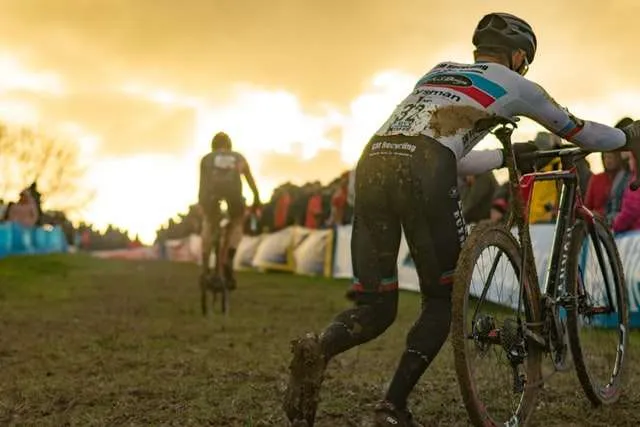
CYCLOPATH: This is someone who enjoys cycling-induced pain and suffering.
CYCOLOGIST: A bike mechanic or rider who knows almost everything about repairing or setting up bicycles.
Recommended reading: Check out other biking puns
D
DAB: When you dab, you lightly place a foot on the ground or just stick it out to prevent a crash or maintain your balance.
DANGER NOODLE: Usually a venomous snake (Not a poisonous noodle, as I used to think!)
DAY WRECKER: when an unforeseeable event ruins your ride, like a crash or a mechanical issue that ends in hike-a-bike.
DERAILLEUR: The component on a bike that shifts the chain from one sprocket/cog to another. Most mountain bikes have a front derailleur and a rear derailleur.
DERAILLEUR HANGER: The rear derailleur attaches to the derailleur hanger. You can find this feature around the rear dropout or axle.
DESCENT: Any downhill section of a trail.
DIALED: When your ride is dialed, you clear a trail section super smoothly. Yay!
DIRECTIONAL: A trail that is designated as either uphill-only or downhill-only. Entire loops can be directional too.
DIRT: The different types of dirt are sandy, loamy, grippy, rocky, gravel, dry, loose, wet, muddy, moist, sticky, hero dirt, velcro, hardpack, kitty litter, moon dust, perfect, fun, dirty, etc.
DIRT JUMP: When you dirt jump, you ride your MTB over heaps of firmed dirt or soil. The firmed heap itself is also called a dirt jump.
DITCH: When you ditch a bike, you dismount safely to avoid something.
DOPE: Really good or awesome.
DORK DISK: Plastic disk that sits in between the spokes and the biggest sprocket on the cassette.
DOUBLE: A gap jump.
DOUBLE TRACK: two side-by-side trails, or often a road upon which riders can ride side-by-side.
DOWNHILL: mountain bike discipline of riding downhill on steep, rough terrain and over features such as rocks, drops and technical obstacles.
DOWNHILL PARK: A series of downhill trails that are often built at ski resorts.
DOWNSHIFT: To downshift is to switch to a lower gear.
DOWNSIDE: A downwards-facing slope designed for building speed.
DOWNSLOPE: The landing surface of a jump, tabletop, or drop. This is usually slanted downwards to prevent the rider from landing on flat ground because it doesn’t feel good.
DRIVE TRAIN: The mechanism that propels a bike forward. It comprises the derailleur, chain, cassette, crankset, and chainring(s).
DRIFT: When a bike slides or drifts, as momentum pulls the rider to the outside of the corner – especially on loose or wet terrain.
DROP: When your front tire can’t keep rolling as before because the elevation of the trail has changed drastically, there’s a drop in front of you. You can only drop into the lower elevation from the upper elevation rather than rolling over it.
DROPOUTS: This is the end of the chainstay or front fork into which the wheel’s axle fits.
DROPPED: When other riders leave newbies behind sometimes, forcing them to pedal more efficiently, that’s being dropped.
DROPPER POST: You can increase or decrease the height of your saddle while riding by pressing a lever. Your seat post is a dropper post.
DROPPING IN: When you say dropping in (yell is more like it), you’re letting your dudes know that you’re about to start riding an extremely steep trail section.
DUAL SUSPENSION: A mountain bike with both rear and front suspension. Also called a full suspension bike.
DUDE/DOOD: An endearment term used among close riding buddies. While traditionally used among guys, it’s now almost universal among both guy and girl riders.
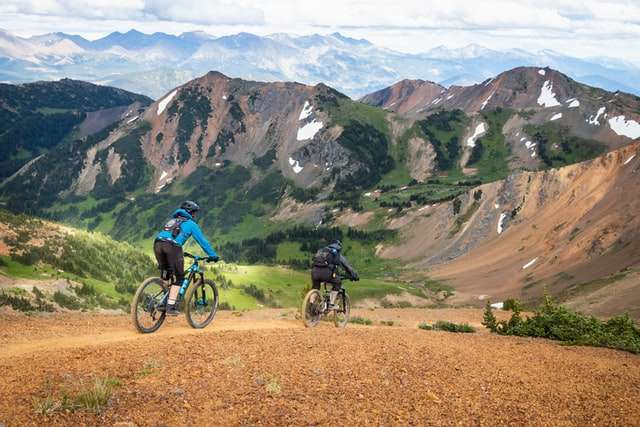
E
EDIT: A short film showcasing the talents of a rider or riders.
ELEVATED TREAD SURFACE: fancy-sounding name for a boardwalk, bridge, or other feature constructed out of wood.
ENDO: A crash where the rider goes over the handlebars.
ENDURO: A style of riding that includes a mix of both XC (cross-country) trails and DH (downhill) descents.
F
FACE SLAPPERS: When trees or overgrown shrubbery hit you on the face while riding.
FALL LINE: The path of least resistance down a hill. Water flows down the fall-line, so trails that go directly down a fall line are subject to lots of erosion and rutting but can also have more grip.
FAT BIKE: (Also Fattie): This is a trail bike with extremely fat tires (3 inches or wider) that help it float over all kinds of surfaces. It navigates excellently through snow, wet sand, mud, roads, hard-packed trails, bike parks, etc. I think it’s the best MTB for winter riding or beachside cycling.
FEATHER/FEATHERING: (Also called Modulating). The rider gently pulls a brake lever to control their speed rather than come to a complete stop. Feathering involves a light touch, and it’s not necessarily constant pressure. Pressure is applied to the brake lever off and on as needed.
FEATURE: A notable obstacle on the trail such as a jump, drop, rock roll, tabletop, rock garden, etc. Features vary widely in technicality from easy rock rollers to steep rock faces.
FERDA GIRLS: Female riders sending it and repping women on the trails!
FIRE ROAD: Graded dirt roads, typically used for service or emergency vehicle access.
FIXIE: A fixed gear bike (one gear) that only rolls when you’re pedaling.
Related post: Fixed gear (fixie) vs Multiple gear bikes
FLAT CORNER: A corner that is flat, with no berm or banking to assist the rider.
FLAT CORNERING: When you ride around a flat corner (one that’s not banked) at speed, that’s flat cornering. Be extra careful when riding flat corners especially if they’re covered with loose gravel. It’s extremely easy to wash out.
FLATTED: When a tire loses air due to a puncture.
FLOW: When corners and other downhill features fit together so well that there is little need to pedal or work to keep the momentum going. It often feels like both rider and bike are floating down the trail.
FORE AND AFT MOVEMENT: moving backwards and forwards on your bike, a technique used during different technical features on the trail.
FORK: the part of your bike that holds your front wheel.
FREERIDE: A mountain biking style that combines aspects of downhill and dirt jumping. The rider goes downhill the whole time and navigates technical trail features while performing mind-blowing tricks.
FRONT TRIANGLE: The main body of the bicycle frame which are the top tube, down tube and seat tube. These three collectively form a triangle.
FULL FACE: A style of mountain bike helmet that has a chin guard for full-face protection. These are typically worn at lift-served bike parks and on rowdy DH trails.
FULL SQUISH: Refers to a full-suspension mountain bike that has both a front fork and a rear shock.
FULLY RIGID: A fully rigid bike has no suspension at all.
G
GAP/ GAP JUMP: a jump constructed with a space, or gap, between the takeoff and landing that the rider must clear (safely).
GASSED: Exhausted.
GEAR MASHER: This is what one calls a biker who pedals slowly in a very high gear while riding.
GEOMETRY: This describes the basic shape of a bike’s frames and the angles between its major components. A bike’s geometry certainly affects its performance.
Find out the differences between mens’ and womens’ bike frames
GNAR: A difficult trail or trail features. GNAR-GNAR is a related term used to describe a very difficult trail.
GNARLY: Trails or features that are difficult, dangerous, and challenging.
GRADIENT: The steepness of a trail. Can be calculated and is measured as a percentage.
GRANNY GEAR: the easiest (lowest) gear on a bicycle.
GRAVEL GRIND: Gravel grind is also a type of race that combines riding on multiple surfaces such as asphalt, pavement, dirt and gravel. The majority of the distance covered is usually on gravel.
GRAVEL: Small rocks found on a trail or road. Now a popular cycling discipline that encompasses riding on any type of dirt road.
GREASE THE BRAKES: when a rider splashes chain oil on the brakes or rims.
GREASY: When mountain bike trails are wet, slippery, and muddy.
GREEN: A beginner skill level trail. To go on a long ride on gravel roads, typically on a dedicated gravel bike. GREENWAY: a wide, flat trail in which there is little to no elevation change, and no technical obstacles.
GRINDER: Someone who does a lot of gravel grind rides.
GRIP: How well your tires connect with the dirt.
GROM: a young mountain biker, typically under the age of sixteen.
GRUNT: A very difficult climb.
H
HALF LID: A bike helmet that isn’t a full-face. In other words, a typical bike helmet.
HANGER: A metal attachment between the rear axle and the derailleur.
HARDPACK: Hardpack – Solid dirt surface on the trail that can be as hard as concrete. This surface has a very low rolling resistance and lots of grip that allows for fast riding.
HARDTAIL: A bike that only has front fork suspension. Hardtails do not have a rear shock, making them harsher but faster to ride.
HEAD TUBE: A component that transmits steering movements from the handlebars to the fork.
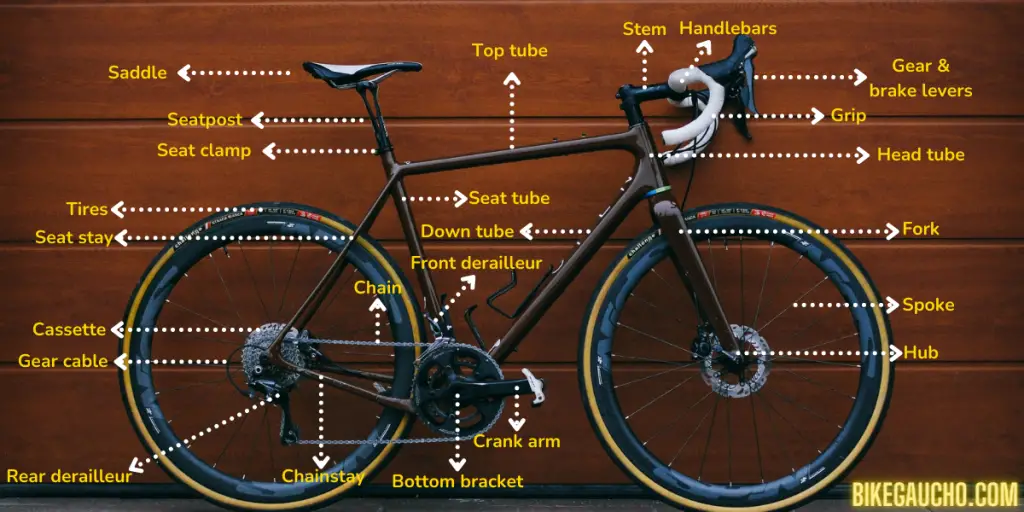
HEADSET: Your bike’s headset is the bearing interface that keeps the fork attached to your bicycle. It is also what allows the fork to turn inside the headtube and lets the handlebars steer your bicycle.
HERO DIRT: Another term for brown pow. Hero dirt refers to optimal riding conditions where the soil or loam is grippy and fast. Hero dirt often comes a day or two after a rain.
HIKE-A-BIKE: When you have to walk your bike instead of ride on steep sections of trail or unrideable terrain. You may have to hike-a-bike when you have an unfixable mechanical on the trail too.
HIP JUMP: A form of jump that requires the rider to change the direction of the bike in mid-air.
HUB: This is the component at the center of the wheel that connects to the wheel’s rim via spokes.
HUCK: When a rider propels themselves off a jump or drop.
HYDRAULIC: Any component that’s controlled by hydraulic fluid rather than mechanical means.
I
IMBA: The International Mountain Biking Association.
INDEX SHIFTING: Modern bicycle shifting features divets in the shifter that allow each click of the lever to correspond with a particular gear.
INNER WIDTH: The width of a rim measured from the inner rim walls.
INVOLUNTARY DISMOUNT: A crash.
ITALIAN PIT STOP: When the fastest members on a group ride take a break on the trail and then immediately leave when the slowest rider rolls up.
J
JRA: Abbreviation for just riding around.
JUMP: When you jump, both wheels of your bike get off the ground at once.
K
KICKER: A super steep jump that amounts to lots of air time and takes you to a greater elevation of the trail.
KICKOUT: A technique that comes in handy when riding switchbacks and tight turns. You simply kick the rear of the bike out to the side as you turn.
KLUNKER (beater): A mountain bike that’s remained in good condition despite being old.
KNOBBY TIRES: Mountain bikes have high-traction, knobby tires designed for rough, off-road riding.
KOM: Abbreviation for King of the Mountain. Anyone who posts the fastest time on Strava for a particular trail section becomes the KOM.
L
LADDER BRIDGE: A ladder bridge is a technical trail feature that’s constructed to help MTBers to get over streams and other similar terrains.
LBS: Abbreviation for Local Bike Shop.
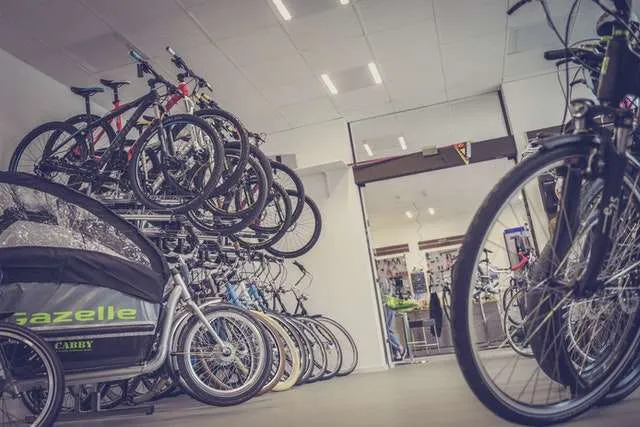
LID: A mountain bike helmet.
LIFT SERVED: Trails at a bike park that are accessed via a gondola or chairlift.
LINE: A particular path through a trail section, especially one that the rider is very familiar with.
LINKAGE: The parts of a frame’s full suspension system that connect the shock and frame. Also known as a faux bar.
LIP: The edge of a trail’s takeoff or landing.
LOAM: Loam is soft, moist, nearly powdery dirt. It’s like hero dirt in many ways.
LOG RIDE: This is a trail feature where you roll over a fallen log, especially one with a flattened top.
LOG ROLL/ LOG PILE: A stack of logs that have been arranged in a way that lets you roll over them with both wheels.
LOOP: A one-direction route starting and ending at the same spot.
LOOSE: When you ride loose, you ride on the edge of control. Loose may also refer to riding conditions where lots of loose gravel or rocks sit on a hard-packed surface.
M
MACHINE BUILT: Trails that were built with a machine tend to be smooth, flowy, fast and might include bermed turns, rollers, and small kickers.
MAMIL: Acronym for Middle Aged Man in Lycra.
MANUAL: A riding skill similar to a wheelie, but instead of pedaling the bike forward, the rider maintains balance on the back wheel while riding downhill.
MCLEOD: Also called a rake hoe. A double-sided blade with a long wooden handle used by trail builders to create nice trails. The tool got its name from its inventor, Malcolm McLeod.
MECHANICAL: Bike parts that aren’t controlled by hydraulics or electronics. Also a breakdown on the trail which could be a flat tire, broken/dropped chain or twisted bars. It’s usually a mechanical that can be fixed trailside.
MOON DUST: Trail conditions after a particularly dry period in which the dirt or soil becomes loose and dry.
MTB: Mountain Bike. Also means mountain biking.
Check out all the benefits of mountain biking
MULLET: A bike that runs a 29-inch wheel in the front and a 27.5-inch wheel in the rear.
MULTI-USE: A trail that is open to bikers, hikers and horseback riders.
MULTI TOOL: A small tool with multiple functions that can be fit into pockets, backpacks and sometimes, frames.
N
NARROW WIDE: A term used to describe the alternating tooth shape of modern 1x drivetrain which holds a chain securely without a chain guide.
NATURAL: Natural trails don’t have many man-made features. They are formed by nature.
NEUTRAL POSITION: The riding position you assume when riding a greenway. There are zero obstacles on the trail and this allows you to relax and maintain your cadence.
NEW SCHOOL: A style of trail building and riding that usually includes machine-built tracks and bike park-style features like wall rides, dirt jumps, boardwalks, and berms.
NIPPLES: They are the small nuts that secure the end of all spokes to the rim of your wheel. They also control spoke tension.
NO FALL ZONE: An area where the consequences of falling are particularly treacherous.
NO-DROP: A group ride where no one is left behind, or dropped.
NOPE ROPE: A snake, typically venomous.
NORBA: The National Off-Road Bicycle Association is a division of the defunct USA Cycling.
NORTHSHORE: Raised wooden boardwalks named for the North Shore area of Vancouver, British Columbia where they were made popular. Also the name of one of the premier off-road trails in the Dallas area.
O
O-RING: The small rubber ring on suspension used to measure sag.
OBSTACLE RIDING: Involves riding a trail with features like rocks, roots, logs etc. that you have to maneuver over while riding.
OFF CAMBER: When the trail surface slopes perpendicular to the riding direction.
OLD SCHOOL: A style of trail and riding that encompasses more raw and rough terrain. Features tend to be natural like rock drops and rock rolls. This is unlike the new-school riding which tends to include machine-built flow trails and bike park features.
ONE BY(OR 1X): A bike’s drivetrain that uses a single front chainring.
OTB(OVER THE BARS): When you fall forward over the handlebars.
OVER COOK: Overcooking a turn or technical feature happens when you come in too fast.
P
PBJ: Pumps Berms Jumps – usually refers to sections of trail that combine all three features.
PEDAL STRIKE: when your pedal strikes the ground or trail obstacles like roots or rocks.
PIMP: Extremely nice mountain bikes or components.
PINCH FLAT: When a tube inside a tire gets pinched between the rim and the tire, which causes you to flat. Also known as a snakebite.
PINNED: To ride really fast.
PIPE CROSSING: These pipes are often placed across the trail for drainage to help prevent erosion.
PLUS SIZE: If a bike has plus-sized tires, it has tires measuring between 2.8″ and 3.25″ in width. All fat tires are plus-sized tires.
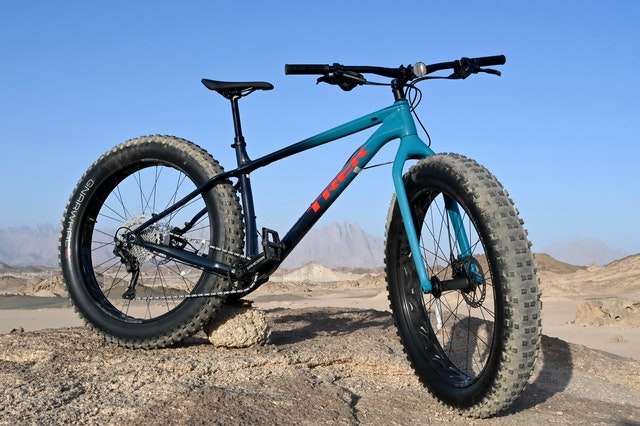
PLUS TIRES: These tires are wider than normal tires but not as wide as that of a fat bike.
PMBIA: Professional Mountain Bike Instructors Association is a global body that certifies our coaches.
PNW: Pacific Northwest.
POACH: Using a private trail without paying an entrance fee, without the land manager’s knowledge and permission, or when otherwise restricted for use.
PR: Personal record.
PRESTA VALVE: The type of valve typically found on high-pressure road bikes and most mountain bikes’ inner tubes.
PRO-LINE: A trail that is so challenging that only pros have the skills to ride it.
PSI: The amount of air pressure that fills a tube or tire.
PUMP TRACK: This is an off-road track with a series of banked turns forming a loop. To make riding a pump track more exciting and challenging, its features are made to be rollercoaster-like. Pump trackers use this course to demonstrate their biking skills.
PUMP: An inflating device for your tires. Also a riding technique which allows a rider to gain speed without pedaling.
Q
QOM: Queen of the Mountain. A female who has the fastest time recorded on Strava on a particular segment.
QUICK RELEASE (QR): A mechanism used to attach a wheel to a bicycle frame.
QUIVER KILLER: A bike that can do it all, from cross country steep terrain to rugged downhill terrain.
R
RACING STRIPE: When mud is flung up your back by your rear tire when riding on a muddy section of trail.
RAD: Radical. If something is rad, it is considered to be much better than something that is simply cool or awesome.
RAIL: Cornering with precision, speed and control (usually a berm) that you are able to leave with more speed than you started with.
RATCHET: A pedaling technique in which you pedal with short, partial strokes to clear obstacles where full pedal strokes aren’t possible.
REACH: The horizontal distance between the center of the head tube and an imaginary vertical line that runs down through the center of the bottom bracket.
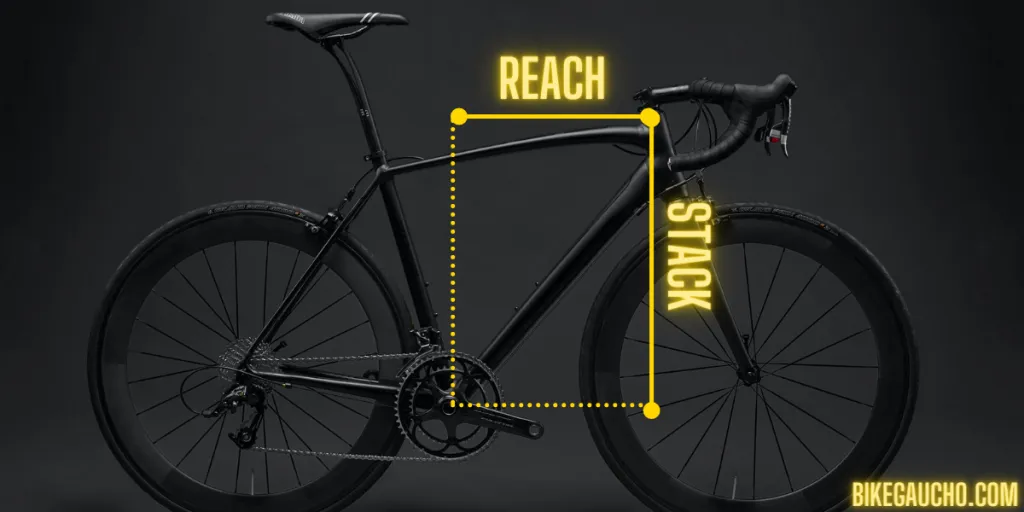
REAR TRIANGLE: This is the portion of a bike frame that connects the rear wheel to the main part of the frame. It consists mainly of the seat stay which runs from the seat tube to the rear wheel, and the chainstay which runs from the bottom bracket to the rear wheel.
On a hardtail bike, the rear triangle is welded to the front triangle. But on a full suspension bike, the rear triangle is a completely separate piece that attaches to the front triangle with pivot bolts.
REBOUND: This is a term used to describe how fast or slow the fork recovers from being compressed.
RIGID: This is a bike that provides zero suspension. It is the opposite of a dual or full-suspension bike.
RIM TAPE: This can be found placed on the inside bed of a rim.
RIM: This is the part of the wheel that the tire sits on.
ROCK GARDEN: Sections of trail where several large or small rocks are concentrated.
ROCK ROLL: A large boulder or rock face that can be ridden.
ROLLER COASTER: A section of trail that features several short ups and downs where the rider feels like they’re riding a roller coaster.
ROLLER: This is a series of small humps in the trail, most effectively ridden by pumping.
ROOST: This happens when a rider enters a banked turn or a berm at speed and the bike’s rear wheel kicks up loads of dirt and dust.
ROOSTER TAIL: When water flies off your back tire while riding a wet surface.
ROTATIONAL VELOCITY: the amount of rotation that a spinning wheel undergoes per unit time.
ROWDY: typically describes rough technical riding.
S
SADDLE: Another (more accepted) name for a bike’s seat.
SAG: This is how much your fork/bike sinks into its travel just by having your body weight on it (with both feet off the ground).
SANDBAGGING: Saying something is easier than it actually is.
SCHRADER VALVE: A pressure valve that looks like a car tire’s valve. It is mostly found on MTB tires with inner tubes.
SCRUB: To scrub is to stay low and go fast when getting over a jump. Also means to adjust speed slowly.
SEAT DROPPER POST: This is a type of seat that allows the rider to raise and lower their seat height while riding.
SEAT STAY: The part of a bike frame that connects the seat tube to the rear wheel.
SEND IT/FULL SEND: To ride a trail aggressively, particularly a difficult section. To go for it. (Past tense: Sent it.)
SEND’ER: An alternative way to say “Send it!”
SESSION: To stop and work on riding through a section of trail or intimidating feature.
SHIFTER: The bike’s lever that you press to shift your gears.
SHOCK: The rear suspension on a full-suspension bike.
SHRALP: Shredding the trail at a whole new level. It’s a cross between shredding the trail and ripping it.
SHRED: To ride a trail at a particularly skillful level, or to ride a trail very fast.
SHUTTLEABLE: Trails that can be accessed via vehicle.
SICK: This is a compliment. It means that something is excellent, wonderful, enjoyable or great!
SIDEHILL: A section of trail that is cut into the side of a hill. One side of the trail is used as a steep drop off while the other side is a mountainside or hillside.
SINGLESPEED: A bike with only one gear attached to the freewheel.
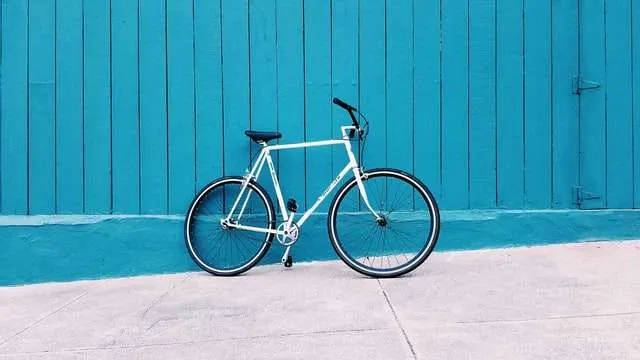
SINGLETRACK: A narrow trail, generally with one line choice.
SKETCHY: If a trail feature such as a wallride feels or looks rickety or unstable, it’s sketchy. Also used to describe a trail section that’s become extraordinarily difficult because of a condition that’s not the norm. For example, a flat corner may prove much harder and riskier to ride because it’s now extremely dry. Such a flat corner is now sketchy.
SKINNY: A technical trail feature that seriously tests your bike handling skills and balance. Usually, skinnies shouldn’t be wider than the tires of your MTB.
SKRRT: Pronounced “skuurt”. MTBers sometimes say “skrrt” in a high-pitched voice when shredding a banked turn or berm.
SLACKSLED: Trail builders make skinnies out of narrow logs or lumber, usually 2 x 4s.
SLOP: This describes the side-to-side wear of the bike chain that leads to slow and inconsistent shifting.
SNAKE BITE: A puncture gained by hitting a square edge. It leaves two parallel holes similar to a snake’s fangs.
SOCIAL TRAIL: This describes a trail that was built without being approved by land managers. Also called illegal trails, pirate trails, secret trails or unsanctioned trails.
SPD: Shimano‘s pedal and cleat technology
SPINE: A narrow and often steep trail that travels down a ridgeline.
SPOKES: These are the rods that connect the hub and rim of your bike.
SQUIRREL CATCHER: A feature at the beginning of a trail that keeps out riders who are not skilled enough to ride the trail. This ‘skill-filter’ can be a top drop-in, a step down or a triple roller.
SS: The accepted acronym for singlespeed.
STANDOVER CLEARANCE: Also known as Standover Height or just Standover. This is the distance measured from the ground to the top of a bike’s top tube. On mountain bikes, this measurement is taken from the middle of the top tube’s slanted angle.
Standover clearance is a part of fitting a bike correctly for a rider. Most riders look for 2 to 4 inches of clearance between the top tube and their crotch when standing flat-footed on the ground over the bike.
STEEL: The classic metal that some purists believe all bike frames should be made of due to its (perceived) superior strength to weight ratio.
In all fairness, steel bike frames are generally stronger than alloy (aluminum) frames and can hold up to much more abuse than carbon frames.
Steel frames also tend to vibrate much less in response to trail conditions compared to alloy frames, thus offering a smoother ride and lessening fatigue.
STEEZY: Riding in such a way that it looks effortless, stylish, and elegant.
STEP UP: A type of jump that sends a rider up from a lower section of trail to a higher elevation.
STEP-DOWN: This is a feature on a trail where the rider jumps down to a lower elevation from a higher section of the trail.
STOKED: The state of being excited.
STOPPIE: A stoppie is a nose wheelie.
STRAVA: A phone app that records ride data such as mileage, GPS, elevation gain/loss, speed compared to other riders, and more.
STRAVASSHOLE: Someone who rides with only one thing in mind: getting a Strava PR. This usually involves having an asshole-type behavior on the trail.
SWITCHBACK: A hairpin turn on a trail that makes climbing and descending more moderate. Switchbacks zig-zag riders up and down steep sections of trail.
T
TABLE TOP: A jump having a flat area between the takeoff and landing.
TACO: If a wheel is tacoed, it’s bent after impact and now looks like a taco shell.
TAIL WHIP: whipping the rear of the bike around in a full 360 in mid-air while still holding onto the handlebars.
TANDEM: Usually a bike built for two riders.
TEETER-FITTER: A manmade feature that looks like a boardwalk or skinny. When a biker rides up one side of the apparatus, their weight on the far end causes it to dip back down to the ground, it reminds you of a see-saw.
TIGHT: A trail with lots of tight turns and other obstacles that make finding flow more difficult.
TIRE CASING: Technologies and materials that prevent slashes, punctures and flats
TIRE SEALANT: Liquid that seals tubeless tires and can help prevent flat tires from punctures.
TIRE TREAD: The various knobs and patterns that make up the contact surface of a tire.
TORQUE WRENCH: A wrench that can tighten a bolt to a specific torque.
TORX WRENCH: Tool to tighten or loosen star-shaped Torx bolts.
TRACK: Another name for a trail, usually downhill or enduro trails. Also could mean race track.
TRACKSTAND: When you trackstand, you stand on level pedals and balance your bike at the same spot. You don’t get your feet off the pedals, and there’s very little movement, if any.
TRAIL DOG: a well trained dog that comes along on mountain bike rides!
TRAILFORKS: A trail and map app that helps mountain bikers find new trails and access maps and locations.
TRAIL SYSTEM: An area with multiple, connected trails.
TRAILHEAD: The start of a trail or that of multiple trails.
TRAVEL: Refers to how much the rear or front suspension can compress before it bottoms out. Generally, the bigger the travel, the more expensive the bike. Travel is expressed in millimeters.
TREE GATE: A tree gate means the available space between any two trees or a cluster of trees.
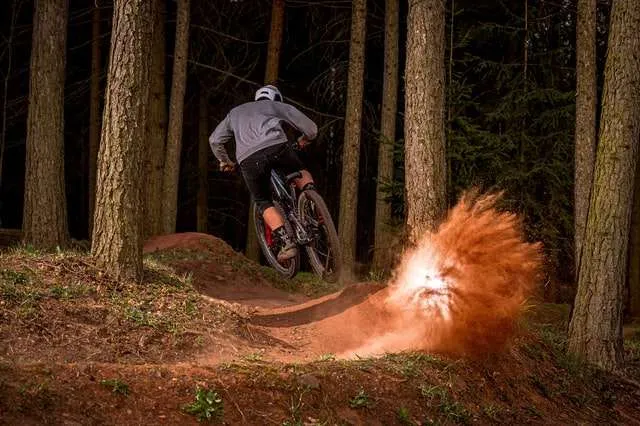
TTF: Any feature, natural or man-made that requires really good bike handling skills to ride like wall rides, rock gardens, drops and jumps.
TUBELESS: Tires that don’t require a tube. They are sealed with tire sealant and allow riders to run lower tire pressure and prevent some puncture flats.
U
UNICYCLE: A one-wheeled MTB.
UPSHIFT: When you shift to a higher gear on your bike, you’re upshifting.
V
VELOMINATI: Roadies have Velominati, generally accepted cycling rules. Visit the Velominati website to read the rules. While these rules apply mainly to road cycling, quite a few of them apply to mountain biking too.
VINTAGE STEEL: An older steel MTB bike.
W
WALLRIDE: Man-made technical trail feature. An extremely steep berm-like wooden structure that you ride at speed. Riding a wallride requires tons of bike handling skills. It’s very easy to spill.
WASH OUT: This is when you’re riding an extremely loose trail section or navigating a loose flat corner and your wheel(s) slide from under you.
WATER BAR: A drop or cut across a section of trail to help prevent erosion by forcing water to flow away from the trail. It is often found on descents so that water can flow away to the sides of the trail rather than down the middle of the trail.
WEIGHT WEENIE: A mountain bike owner who is more concerned with how many ounces an individual bike component saves from their bike’s total weight than becoming a better rider.
WHEEL BASE: The measurement of distance from the center of a bike’s rear wheel to the center of the front wheel.
WHEELIE: Lifting the front wheel off of the ground while pedaling.
WHIP: A trick performed during a jump while the bike is in midair. The rider stylishly pushes the bike sideways in the air and then whips the rear wheel back in line before making contact with the ground.
WIPE OUT: A particularly spectacular crash.
WONKY: When something on your bike is not working properly or feels wrong.
X
XC: Cross-country.
Y
YARD SALE: When a rider crashes and all of their things like water bottles, snacks, backpack, seat bag, etc fly everywhere, It looks as if they set out all their stuff out on display for a yard sale.
YEW: This is a general expression of excitement.
Z
ZONE: When the flow is so good and your riding is so good it feels like a perfect day on the trail.
Yew made it! I hope that the buffet of mountain biking terms above has whetted your appetite. Now, you can converse with friends about MTB, fully armed with the words of the trail. Feel free to mention those slangs you think I missed in the comments below. Cheers!

